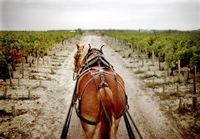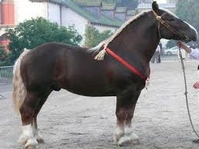I received an email recently from winemaker Mark Lyon, bringing me up to date on his investigation into using horse-power in the Sebastiani vineyards in California. Real horses, of course. Mark is on his way this month to Chateau Pontet-Canet, the esteemed Left Bank Bordeaux producer, for further research. After a decade of meticulously detailed vineyard management Pontet-Canet now qualifies for100% Biodynamic certification (ECOCERT and BIODIVIN). One of the dramatic and colorful “green” changes in the vineyard is the presence  of Kakou, Reine, Opal and Surprise, the four draft horses who have been brought in to help plow the vineyards.
of Kakou, Reine, Opal and Surprise, the four draft horses who have been brought in to help plow the vineyards.
One might be forgiven for thinking that the presence of horse-powered plows in the vineyard is a quaint, gimmicky PR strategy designed to convince us that winegrowing is part of an historic, Old-World tradition rather than a modern industry, but Pontet-Canet co-owner Alfred Tesseron emphasizes that the use of horses has nothing to do with romantic notions of “going back in time.” On the contrary, these powerful animals are part of P-C’s campaign to improve the overall health of the vines, and therefore the quality (and value) of the wines. One of the main virtues of animal-drawn plows versus diesel tractors is that the horses compact the soil much less severely.
Covering 81 hectares (more than 200 acres) Pontet-Canet is one of France’s largest Biodynamically farmed vineyards. The chateau produces 20-25,000 cases a year, with bottles selling for roughly $50 and ranging up to $100, and reviews of recent vintages have been glowing. But P-C is by no means the only top-tier French producer to be recruiting horses for vineyard work. In Alsace, for example, prestige estates such as Schlumberger, Dirler Cadé and Zind-Humbrecht have all invested in horse power. The United States has been a little slower to jump into the ring, although Mark Lyon’s interest and enthusiasm may represent a turning point. In his email to me, Mark shared his eagerness about purchasing some Percheron horses for the Sebastiani vineyards.
“I am very excited about this,” he wrote. “These magnificent horses literally built the eastern and mid-western USA in the 19th through early twentieth centuries. The Amish still use them for all their hauling, farming and transportation needs.”
His enthusiasm is contagious, but one might ask what Kakou and his equine colleagues think of being pressed into service in the vineyard? By all accounts, Percherons, like Pontet-Canet’s  Breton horses, were originally bred for war, then were used for pulling stage coaches, and eventually for work in agriculture fields. They tend to be strong, intelligent, and dedicated, well, workhorses. The horses may not belong to a union, as such, but at Pontet-Canet, the working conditions seem good. I don’t want to anthropomorphize too much, but they do seem to enjoy the sun and the fresh air and human companionship. Their workdays are interspersed with frequent rests and energy treats. Doc, one of the Percherons who helps bring in the harvest at Oregon’s Illahe Vineyard, is even said to like the smell of wine. Another fan of Oregon Pinot Noir perhaps?
Breton horses, were originally bred for war, then were used for pulling stage coaches, and eventually for work in agriculture fields. They tend to be strong, intelligent, and dedicated, well, workhorses. The horses may not belong to a union, as such, but at Pontet-Canet, the working conditions seem good. I don’t want to anthropomorphize too much, but they do seem to enjoy the sun and the fresh air and human companionship. Their workdays are interspersed with frequent rests and energy treats. Doc, one of the Percherons who helps bring in the harvest at Oregon’s Illahe Vineyard, is even said to like the smell of wine. Another fan of Oregon Pinot Noir perhaps?
7
